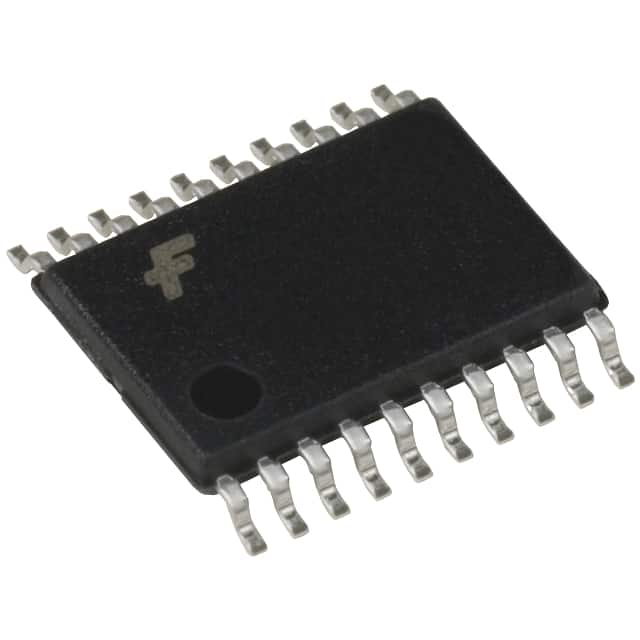Encyclopedia Entry: 74ABT241CMTC
Product Overview
Category
The 74ABT241CMTC belongs to the category of integrated circuits (ICs) and specifically falls under the family of ABT series ICs.
Use
This IC is commonly used in digital electronic systems for signal amplification, buffering, and level shifting purposes. It is designed to provide high-speed performance while consuming low power.
Characteristics
- High-speed operation: The 74ABT241CMTC offers fast switching times, making it suitable for applications that require quick data transfer.
- Low power consumption: This IC is designed to minimize power consumption, making it energy-efficient.
- Wide operating voltage range: It can operate within a wide voltage range, typically between 4.5V and 5.5V.
- Output drive capability: The IC has a high output drive capability, allowing it to drive capacitive loads efficiently.
Package and Quantity
The 74ABT241CMTC is available in a small-sized surface mount package known as TSSOP (Thin Shrink Small Outline Package). It consists of 20 pins arranged in a compact layout. The IC is typically sold in reels or tubes containing multiple units.
Specifications
- Supply Voltage Range: 4.5V to 5.5V
- Input Voltage Range: 0V to VCC
- Operating Temperature Range: -40°C to +85°C
- Maximum Propagation Delay: 6 ns
- Maximum Output Current: ±24 mA
Pin Configuration
The pin configuration of the 74ABT241CMTC is as follows:
┌───┐
OE1 │1 20│ VCC
A1 │2 19│ B1
A2 │3 18│ B2
A3 │4 17│ B3
A4 │5 16│ B4
GND │6 15│ B5
Y1 │7 14│ B6
Y2 │8 13│ B7
Y3 │9 12│ B8
Y4 │10 11│ B9
└───┘
Functional Features
- Output Enable (OE) control: The IC features an OE input pin that allows the user to enable or disable the outputs. When OE is high, the outputs are active, and when it is low, the outputs are in a high-impedance state.
- Bidirectional operation: The IC supports bidirectional data flow, allowing data to be transmitted in both directions.
- Non-inverting outputs: The outputs of the IC are non-inverting, maintaining the same logic level as the inputs.
Advantages and Disadvantages
Advantages
- High-speed operation enables efficient data transfer.
- Low power consumption makes it energy-efficient.
- Wide operating voltage range provides flexibility in various applications.
- Compact package size saves board space.
Disadvantages
- Limited output current may restrict its use in certain high-current applications.
- Sensitivity to electrostatic discharge (ESD) requires proper handling during assembly and usage.
Working Principles
The 74ABT241CMTC operates based on complementary metal-oxide-semiconductor (CMOS) technology. It utilizes a combination of transistors and logic gates to amplify and buffer digital signals. The IC's internal circuitry ensures fast switching times and low power consumption.
Application Field Plans
The 74ABT241CMTC finds applications in various digital systems, including but not limited to: - Microprocessors and microcontrollers - Data communication systems - Memory interfaces - Industrial automation systems - Consumer electronics
Alternative Models
Several alternative models with similar functionality are available in the market. Some notable alternatives to the 74ABT241CMTC include: - 74HC241: A CMOS IC with comparable characteristics but operates at a higher voltage range. - SN74LS241: A TTL (Transistor-Transistor Logic) IC offering similar features but with different power requirements.
These alternative models can be considered based on specific project requirements and compatibility with existing designs.
In conclusion, the 74ABT241CMTC is a high-speed, low-power integrated circuit commonly used for signal amplification and buffering in digital electronic systems. Its compact package, wide operating voltage range, and bidirectional operation make it suitable for various applications. However, its limited output current and sensitivity to ESD should be taken into consideration during usage.
Lista 10 Vanliga frågor och svar relaterade till tillämpningen av 74ABT241CMTC i tekniska lösningar
Sure! Here are 10 common questions and answers related to the application of 74ABT241CMTC in technical solutions:
Q: What is the 74ABT241CMTC? A: The 74ABT241CMTC is a 8-bit buffer/line driver with 3-state outputs, commonly used in digital logic circuits.
Q: What is the maximum operating voltage for the 74ABT241CMTC? A: The maximum operating voltage for the 74ABT241CMTC is typically 5.5V.
Q: Can the 74ABT241CMTC be used as an input buffer? A: Yes, the 74ABT241CMTC can be used as an input buffer to amplify and condition signals before they enter other components.
Q: How many inputs and outputs does the 74ABT241CMTC have? A: The 74ABT241CMTC has 8 inputs and 8 outputs.
Q: What is the purpose of the 3-state outputs in the 74ABT241CMTC? A: The 3-state outputs allow multiple devices to share a common bus without interfering with each other.
Q: Can the 74ABT241CMTC be used in high-speed applications? A: Yes, the 74ABT241CMTC is designed for high-speed operation and can be used in applications that require fast signal propagation.
Q: Does the 74ABT241CMTC have built-in protection against electrostatic discharge (ESD)? A: Yes, the 74ABT241CMTC typically includes ESD protection to safeguard against damage from static electricity.
Q: Can the 74ABT241CMTC be used in both TTL and CMOS logic systems? A: Yes, the 74ABT241CMTC is compatible with both TTL and CMOS logic levels, making it versatile for various applications.
Q: What is the maximum output current of the 74ABT241CMTC? A: The maximum output current of the 74ABT241CMTC is typically around 24mA.
Q: Are there any specific precautions to consider when using the 74ABT241CMTC? A: It is important to ensure proper power supply decoupling and avoid exceeding the maximum voltage and current ratings specified in the datasheet.
Please note that the answers provided here are general and may vary depending on the specific datasheet and manufacturer's specifications for the 74ABT241CMTC.


